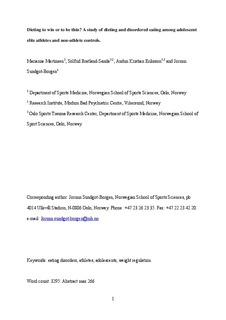| dc.contributor.author | Martinsen, Marianne | |
| dc.contributor.author | Bratland-Sanda, Solfrid | |
| dc.contributor.author | Eriksson, Audun | |
| dc.contributor.author | Sundgot-Borgen, Jorunn | |
| dc.date.accessioned | 2010-09-15T13:14:59Z | |
| dc.date.available | 2010-09-15T13:14:59Z | |
| dc.date.issued | 2010-01 | |
| dc.identifier | Seksjon for idrettsmedisinske fag / Department of Sports Medicine | |
| dc.identifier.citation | British Journal of Sports Medicine. 2010, 44(1), 70-76 | en_US |
| dc.identifier.issn | 1473-0480 | |
| dc.identifier.uri | http://hdl.handle.net/11250/170813 | |
| dc.description | I Brage finner du siste tekst-versjon av artikkelen, og den kan inneholde ubetydelige forskjeller fra forlagets pdf-versjon. Forlagets pdf-versjon finner du på http://bjsm.bmj.com: http://dx.doi.org/10.1136/bjsm.2009.068668 / In Brage you'll find the final text version of the article, and it may contain insignificant differences from the journal's pdf version. The definite version is available at http://bjsm.bmj.com: http://dx.doi.org/10.1136/bjsm.2009.068668 | en_US |
| dc.description.abstract | Objective: To examine the prevalence of dieting, reasons for dieting and prevalence of disordered eating among adolescent elite athletes and age-matched controls, and to examine the differences between athletes competing in leanness and non-leanness sports. Methods: First-year students of 16 different Norwegian Elite Sport High Schools (athlete group, n = 682) and two randomly selected ordinary high schools from a county representative of the general Norwegian population (control group, n = 423) were invited to participate in this cross-sectional study. A total of 606 athletes and 355 controls completed the questionnaire, giving a response rate of 89% and 84%, respectively. The questionnaire contained questions regarding training patterns, menstrual status and history, dieting, use of pathogenic weight control methods and the drive for thinness (DT) and body dissatisfaction (BD) subscales from the Eating Disorders Inventory. Main outcome measure: Disordered eating, defined as meeting one or more of the following criteria: DT score ?15 (girls) and ?10 (boys), BD score ?14 (girls) and ?10 (boys), body mass index <17.9 kg/m2 (girls) and <17.5 kg/m2 (boys), current and/or ?3 previous efforts to lose weight, use of pathogenic weight control methods and self-reported menstrual dysfunction. Results: A higher prevalence of control subjects were dieting and classified with disordered eating compared with the athletes. An improvement of appearance was a more common reason for dieting among controls compared with athletes. No differences in dieting or disordered eating were found between leanness and non-leanness sports athletes. Conclusions: Self-reported disordered eating is more prevalent among controls than adolescent elite athletes, and losing weight to enhance performance is an important reason for dieting among adolescent elite athletes. | en_US |
| dc.language.iso | eng | en_US |
| dc.publisher | BMJ | en_US |
| dc.subject | adolescent | |
| dc.subject | case-control studies | |
| dc.subject | diet, reducing | |
| dc.subject | eating disorders | |
| dc.subject | Norway | |
| dc.subject | prevalence | |
| dc.subject | questionnaires | |
| dc.subject | regression analysis | |
| dc.subject | sports, statistics and numerical data | |
| dc.subject | thinness, epidemiology | |
| dc.title | Dieting to win or to be thin? a study of dieting and disordered eating among adolescent elite athletes and non-athlete controls | en_US |
| dc.type | Journal article | en_US |
| dc.type | Peer reviewed | en_US |
| dc.subject.nsi | VDP::Social science: 200::Social science in sports: 330::Other subjects within physical education: 339 | en_US |
| dc.source.pagenumber | 70-76 | en_US |
| dc.source.journal | British Journal of Sports Medicine | |
